Whenever Napoleon’s Grande Armée is discussed by wargamers, the conversation seems to focus on the legendary Old Guard, the terror of the Pas de Charge drumbeat, or the earth-shaking power of the massed artillery batteries. Often when cavalry is mentioned, the spotlight is occupied by their commanders, men like Lasalle and Ney, with the troopers and specific units under their command relegated to mere instruments of their commanders’ wills, an amorphous mass of horseflesh and steel. This is a real shame, as the French cavalry of the Napoleonic Wars were some of the most iconic and effective horsemen of their era, and absolutely deserve their day in the sun (or under the lights!) on the tabletop battlefield.
Today we’ll be taking a look at the Gros Frères or ‘big brothers’ – the famous Cuirassiers, Carabiniers, and Dragoons of the French heavy cavalry. With perhaps less dash (but certainly rather more muscle) than the Beau Sabreurs (dashing adventurers) of the light horse, the French heavies were the product of a national culture of armoured cavalrymen dating back to the first millennium AD. Like their British Army counterparts, these were indeed ‘big men on big horses’, who lived to ride roughshod directly over and through any opposition in their path, oftentimes disregarding frankly suicidal odds in their pursuit of glory and victory.
Although an artilleryman by trade, Napoleon held his cavalry in high regard, famously saying “Cavalry is useful before, during and after the battle.“ While the so-called ‘Arme Blanche’, the light cavalry, would indeed conduct extensive reconnaissance and pursuits before and after engagements, the heavy cavalry were very much focused on the ‘during’! Used decisively en masse, as they so often were by Murat and Ney, most Allied cavalry simply could not compete with their excellent drill and skilled horsemanship. Even Wellington recognised their particular quality when used in great numbers, and was reluctant to commit his own cavalry without significant numerical superiority. Although the quality of French cavalry troopers and their mounts diminished (along with that of the entire Grande Armée) as the Napoleonic Wars dragged on, by Waterloo they were still arguably the finest and most feared in all of Europe.
Carabiniers
Of the three main types of French heavy cavalry, we’ll begin with the Carabiniers. Historically an elite formation of two regiments, receiving extra pay, and originally armed with sabres and pistols and wearing tall bearskins, by Waterloo they had been given helmets and breastplates to match those of the Cuirassier regiments and received short cavalry carbines – our boxed set represents them in this latter configuration. Serving throughout Napoleon’s campaigns, the Carabiniers fought well against the Austrians, although the toll taken on them by the opposing Uhlans prompted their adoption of Cuirassier armour. During the nightmarish retreat from Russia the Carabiniers suffered dreadfully, losing enormous numbers of men and all of their horses. Although both regiments were rebuilt, many of the hastily-trained young recruits were not of the expected quality, and the regiments’ reputations suffered for it. At Leipzig they panicked in the face of Austrian Hussars, while on several other occasions they were handily beaten and routed by Russian Cossacks. While some Carabiniers and other cavalrymen (enough to form a ‘Bourbon Cavalry Corps’) deserted and joined Wellington before Waterloo, those who remained loyal to their Emperor gave a good account of themselves in that battle, charging the British late in the day as part of Kellerman’s Corps. On the tabletop, they have the same stat line as the ubiquitous Cuirassiers (to be discussed momentarily), as despite their firmly-held belief in themselves as the elite of the elite they really performed much the same role in much the same manner!
Cuirassiers
Most numerous and well-known of the French heavies were the Cuirassiers, known as the ‘Gilets de Fer’ (steel vests) for their armour. While the other types of cavalry had their own vital roles to play in battle, it was the Cuirassiers, armoured descendants of the medieval knight, who could (and often did) turn the tides of battles with their sheer weight and brute force. Always dangerous in attack, they were by and large very well utilised and institutionally brave men. While comparable in role to the British Union Brigade, the Cuirassiers were far more numerous and successful, with a battle record the envy of all other heavy cavalrymen. From the very beginning to the final conclusion of the Napoleonic Wars, the Cuirassier regiments provided their beloved Emperor with an unflinchingly brave strike force, capable of destroying almost anything in their path with contemptuous ease. At Borodino the Cuirassiers performed a seemingly impossible task for cavalrymen – the capture of a Russian redoubt – while at Quatre Bras and Waterloo they took a number of Allied Colours. The exact number is hotly disputed, but it was certainly greater than the two Eagles taken by the British cavalry during the battle. While disciplined, eager, and brutally competent killers, the Cuirassiers were of course not invincible. Like all cavalry, they could be stopped by close-range use of canister shot from brave (or foolhardy) artillerymen, but the particular nemesis of the Cuirassier was the infantry square. Recalling the pike formations their ancestors would have feared and respected, the Russians at Borodino and most famously the Allies at Waterloo made good use of the tactic to preserve their infantry. Despite a series of increasingly desperate charges, the squares at Waterloo held firm throughout the day, with the French cavalry unable to have an impact on the battle to which they were accustomed. Splendidly equipped with helmet and breastplate and bearing their monstrous Klingenthal-made straight swords, the Cuirassiers on the Epic Battles tabletop have a staggering Hand-to-Hand value of 9, along with the Reliable and Heavy Cavalry D3 rules. Used well, they can smash through almost anything the Allies might care to throw at them… provided they’re kept away from the squares!
Dragoons
Finally, we come to the Dragoons, of which only two regiments (the 2nd and 7th) fought at Waterloo. Something of a relic of the previous era of warfare, the Dragoon was more properly an infantryman on horseback than a true cavalryman. Nevertheless, when mounted they served in the same shock role as their heavier brethren, albeit on smaller horses and in less glamorous uniforms. Effective early in the war when used as cavalry, the Grande Armée always struggled to find enough mounts for its Dragoons, resulting in many serving purely on foot, while others could only field a portion of their strength on horseback. While less well-regarded or equipped than the ‘real’ cavalry, the Dragoons nonetheless fought bravely. Although they were frequently bested by British cavalry (better trained and on finer horses) in the Peninsular Campaign, they did manage the stunning capture of Lord Paget, later to command the Allied cavalry at Waterloo. By the Hundred Days campaign, many of the Dragoon regiments had given up their unwieldy infantry muskets, and fought purely as mounted troops – we’ve included them as such in Epic Battles. Wearing their distinctive brass Grecian helmets and otherwise rather plain uniforms, they have a very respectable Hand-to-Hand value of 8, and with the Heavy Cavalry +1 rule they are certainly more than capable of keeping up with the Cuirassiers and Carabiniers.
The French Heavy Cavalry Brigade boxed set gives you enough for a regiment each of Cuirassiers, Carabiniers, and Dragoons, with the Cuirassiers being appropriately one base larger. There’s also a battery of the always-useful 6pdr guns, crewed by the mobile Horse Artillery, to give your brigade some fire support.
Grab your breastplate and mount up, trooper. The Rosbifs are sure to break soon – and we will be the ones to send them running. Vive l’Empereur!
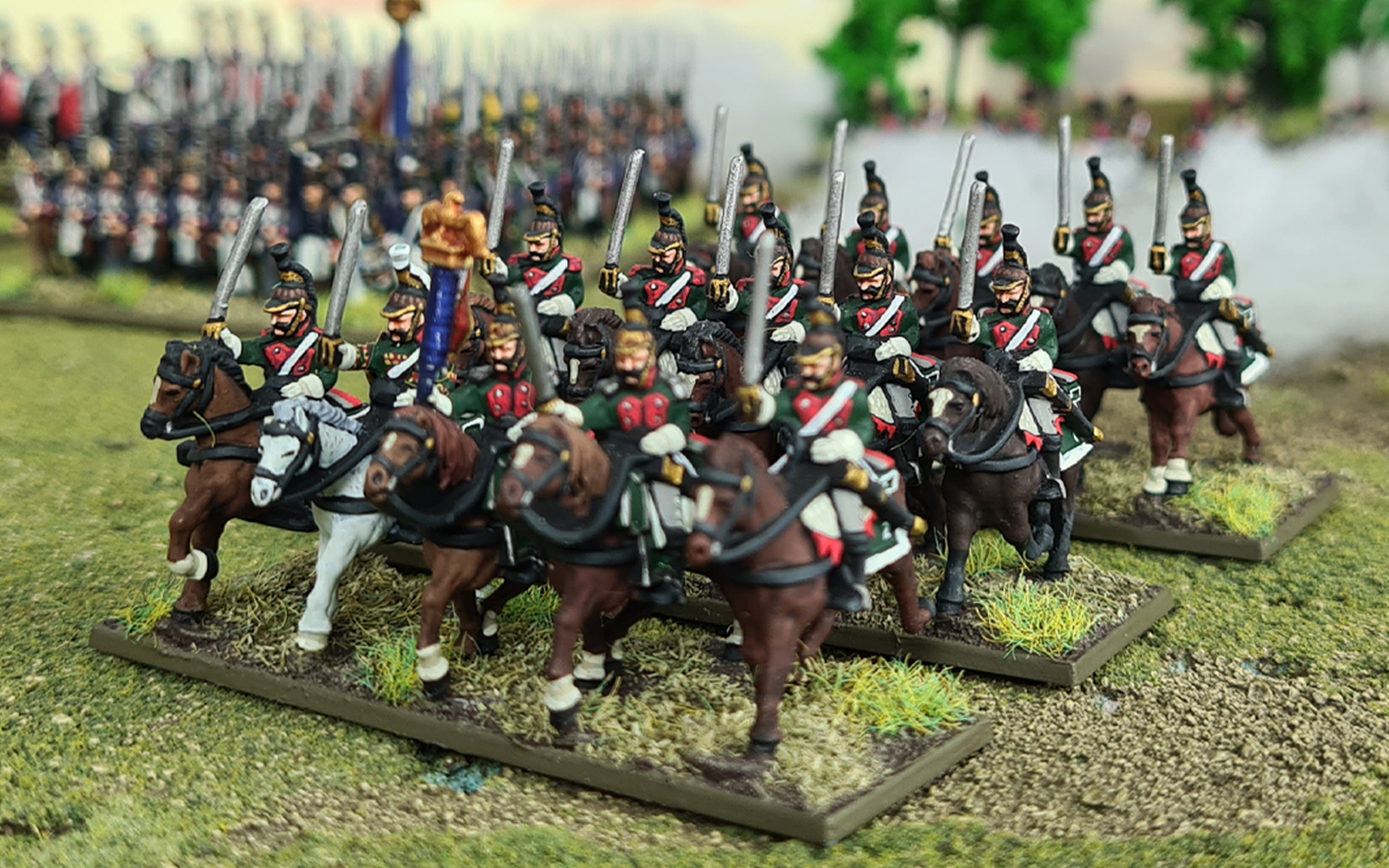
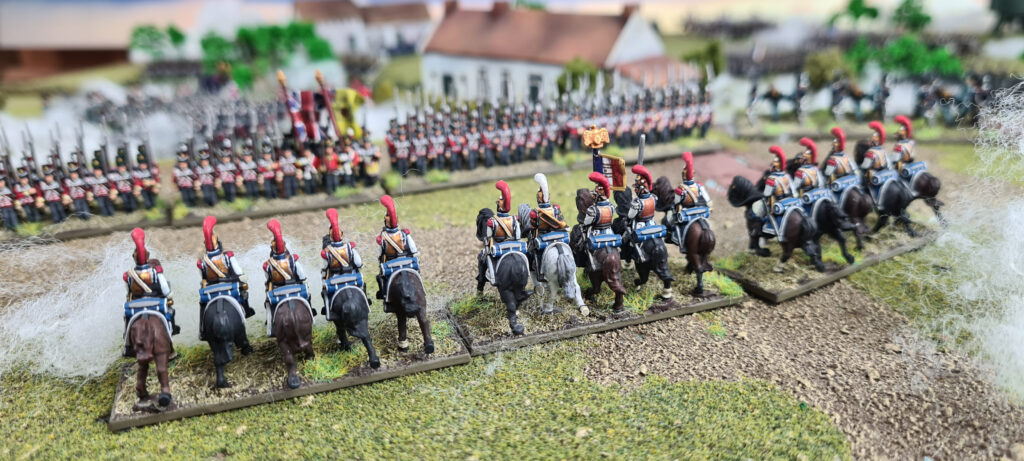
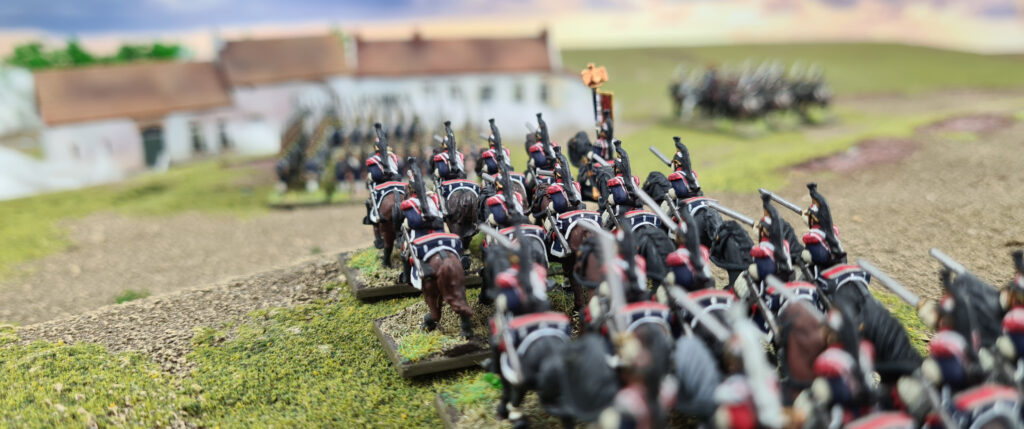
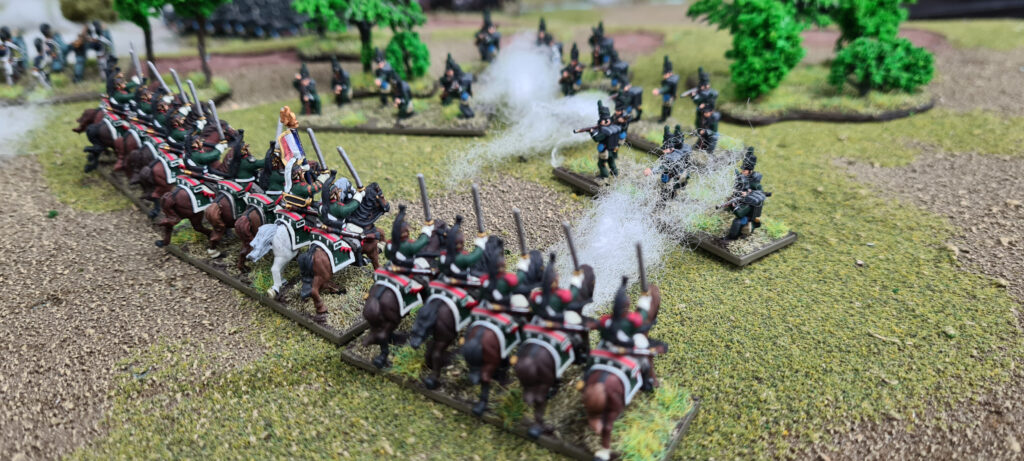
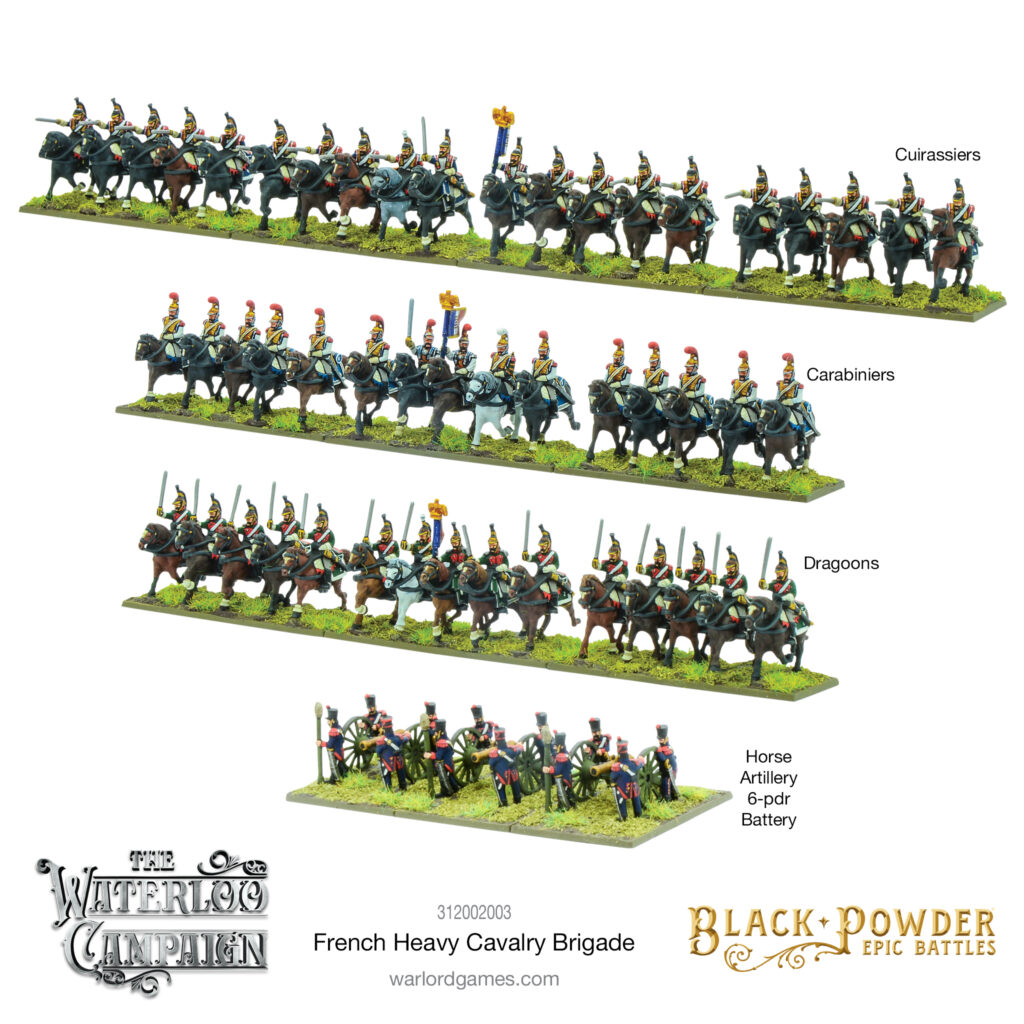
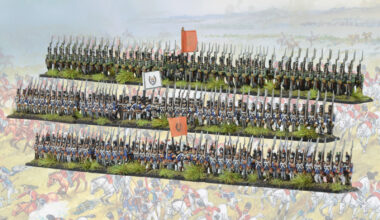
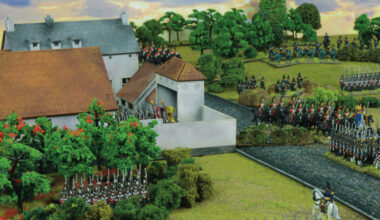
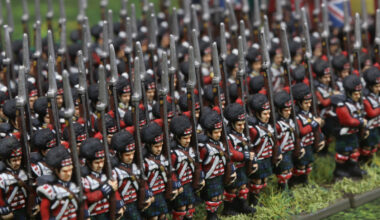
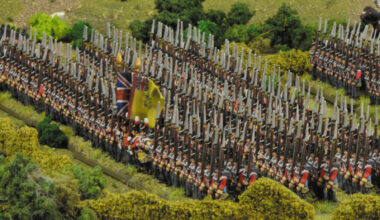
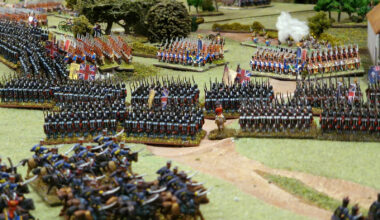
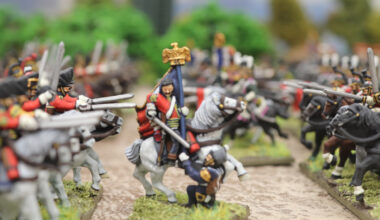
1 comment
Nice review and great pictures – while there were not many dragoons at Waterloo, looking at the big picture the Grand Armee had 2 regiments of carabiniers, thirteen regiments of cuirassiers, and thirty regiments of dragoons. While the cuirassiers have and always will be my favourite French cavalry, the dragoons did a lot of the thankless but critical work that wins battles. As for their value, one of my favourite quotes by Napoleon was “It is the cavalry’s task to pursue a victory and forbid a beaten enemy the opportunity to rally – without cavalry, battles remain unresolved.”
Comments are closed.